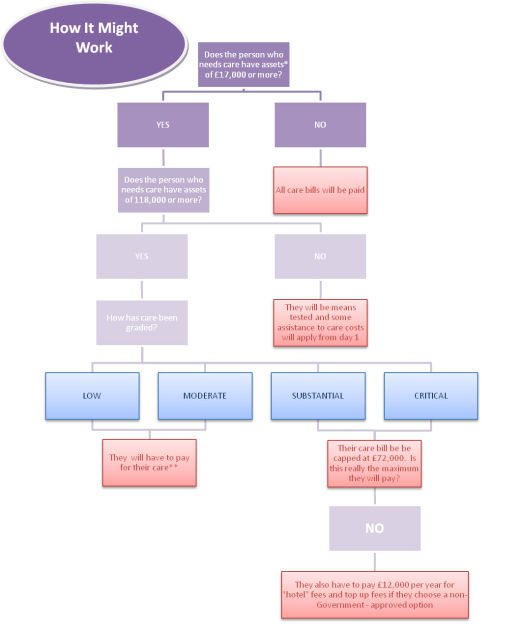Chris Moon-Willems writes about the government's proposed changes to means testing for social care.
Author: Chris Moon-Willems
There has been a lot of recent interest in the cap on long term care fees, but how does it all work? As always, it is complicated, but I hope you will find the diagrams below helpful in working out how it works now, in 2013 and how it might work in 2016:

After 2016 the government are proposing further large scale social care reforms. The government suggest we will only have to pay £72,000 (only!) for care after 2016, but on closer inspection the reality is, it could be considerably more, as you can see below:

Once you have established that the person is eligible for care, there are still further considerations to take into account:
The figures used above are examples, and do not take into account inflation or other factors. They are fictitious, although as realistic as possible.
The stringent rules around care home fees are only one aspect of our grossly underfunded care system, and not the worst. The decision by most local authorities not to fund people who are in desperate need, but not technically ‘critical’ is an even worse problem.
The insurance industry will be planning ways to cover that first £72,000 of costs. With the exorbitant mark-ups for which the industry is known, these products will be unaffordable for many. Experience has also shown that the market for insurance products to fund elderly care has hitherto been very small, largely because most people believe that social care, like the NHS, is free at the point of need and therefore fail to plan for them.
While I am pleased that at last a decision is made to place a cap on care fees for older people, which is particularly important for the 41 per cent of elderly people in the care system who are “self-funders” because their needs are not considered high enough and/or they have over £23,250 in assets including property. Many are not very wealthy and I believe they are among the most overlooked and underserved in the care system.
They are people like you and me who have worked hard all our life for a pension that will make us ineligible for most welfare benefits, yet have savings that will not last long when paying care fees.
Once people realise that they are likely to die before reaching the ‘cap’ what happens to the ‘peace of mind’ they were promised? This will mostly affect Southern areas in the country where the proportion of pure ‘self-funders’ in residential care are the highest, primarily because property costs are so high.
The publisher is Relative Matters.
Long Term Care Fees - The Truth © Chris Moon-Willems 2013.
All Rights Reserved. No part of this paper may be reproduced in any form without permission from the publisher except for the quotation of brief passages in reviews.
local government, social care, Article